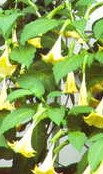 Native to central Columbia and Ecuador, where it grows on the slopes of the Andes, is an evergreen shrub or small tree. It is considered extinct in the wild but is grown as a garden plant and used in beds as well as in containers. The dark green leaves are oval and up to sixteen inches long and six inches wide. The white or yellow to apricot flowers are trumpet shaped and up to six to ten inches long. They are pendulous, have a strong aromatic fragrance at night and are produced over a long bloom time dependent on the temperature. The seeds are large and brown to black. In cool climates the plant is best grown in a container and taken indoors for the winter where it should be kept at about 50o F and out of the light so that it can go into dormancy. In the spring it will resprout and resume its prolific production of flowers. The stems, leaves, flowers and seeds are poisonous and can cause hallucinations, seizures, convulsions and even death.
Native to central Columbia and Ecuador, where it grows on the slopes of the Andes, is an evergreen shrub or small tree. It is considered extinct in the wild but is grown as a garden plant and used in beds as well as in containers. The dark green leaves are oval and up to sixteen inches long and six inches wide. The white or yellow to apricot flowers are trumpet shaped and up to six to ten inches long. They are pendulous, have a strong aromatic fragrance at night and are produced over a long bloom time dependent on the temperature. The seeds are large and brown to black. In cool climates the plant is best grown in a container and taken indoors for the winter where it should be kept at about 50o F and out of the light so that it can go into dormancy. In the spring it will resprout and resume its prolific production of flowers. The stems, leaves, flowers and seeds are poisonous and can cause hallucinations, seizures, convulsions and even death.
Type: Evergreen shrub or small tree
Outstanding Features: Huge flowers; tropical foliage
Form: Vase-shape
Growth Rate: Rapid
Bloom: Pendulous, white or yellow to apricot, trumpet-shaped, 6-10” long flowers with strong fragrance at night; summer to year round bloom depending on temperature.
Size: 16-33’ H x 6.5-13’ W
Light: Full sun
Soil: Fertile, moist, well-drained
Hardiness: Zones 10-11
Care: Can be cut down to within six inches of the ground in October to maintain size but over time the flowering will decline.
Pests and Diseases: Snails and slugs; in the greenhouse susceptible to mealybugs, red spider mite, and whitefly.
Propagation: Seed (60 F in spring); semi-ripe or softwood cuttings 4-6” long in sandy, well-drained medium with bottom heat of 65-70 F in spring or late autumn.
